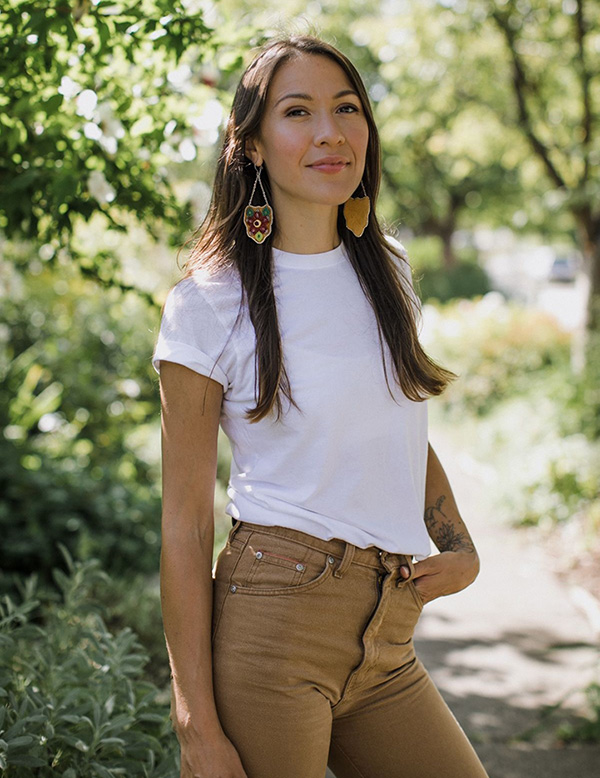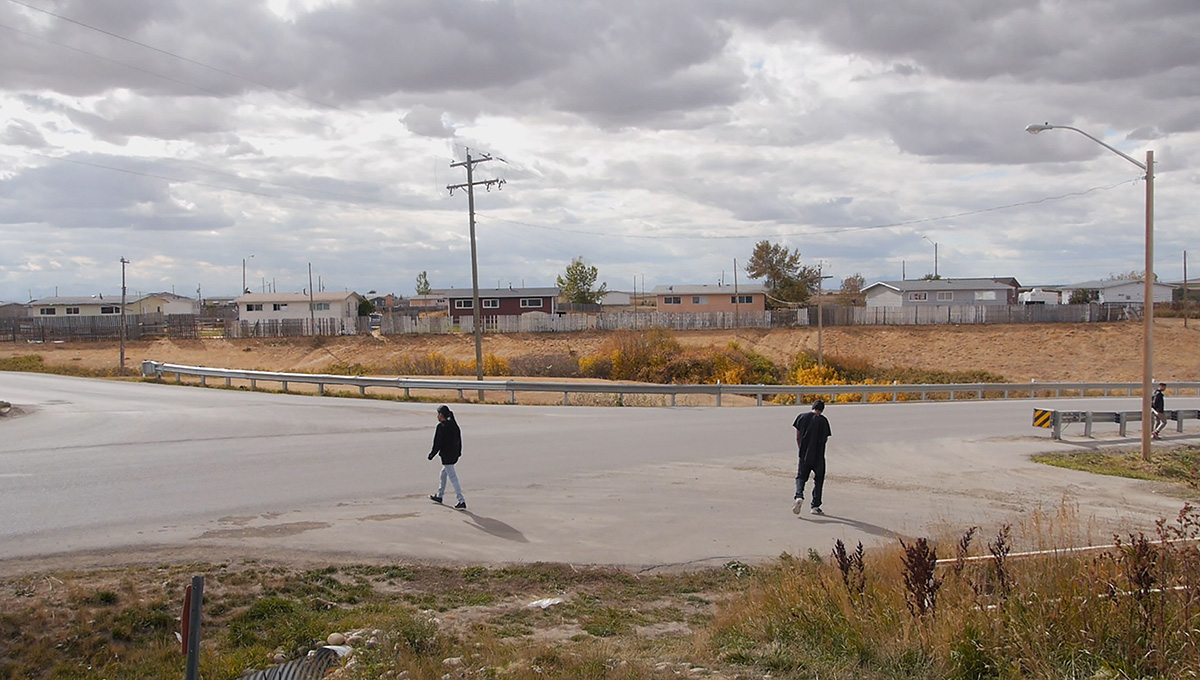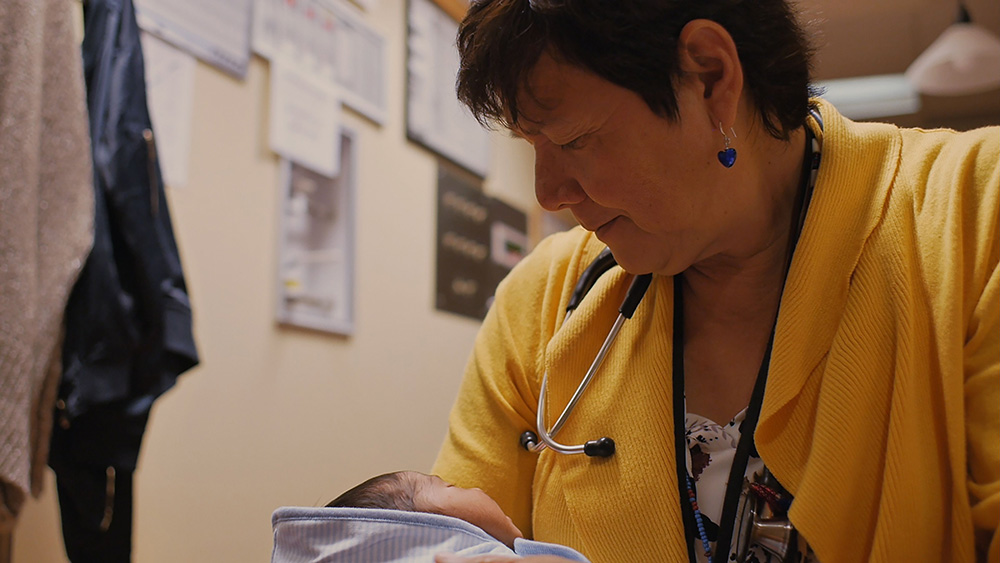There is a scene in Kímmapiiyipitssini: The Meaning of Empathy that serves as a telling moment in this moving, deeply personal story chronicling harm-reduction efforts on the Kainai (Blood) Nation reserve in southern Alberta.
Filmmaker Elle-Máijá Tailfeathers is with her mother and other Kainai community members, visiting Insite’s supervised drug consumption site in Vancouver. At one point, one of the staff members offers a nugget of wisdom: “Harm reduction isn’t about celebrating addiction; it’s about celebrating people’s lives without judgement.”
It’s a touching and timely observation.
2021 marks the five-year anniversary of the year that B.C. declared the opioid overdose crisis a public health emergency. It’s the only province in Canada to have done so. But it’s not alone in its battle with an epidemic that has taken thousands of lives and affected thousands more.
Along with B.C. — which saw 1,716 overdose deaths last year — Alberta is one of the provinces that has been hardest hit by the crisis. In 2020, its worst year for overdose deaths yet, 1,316 drug-related fatalities were recorded.
This year has already seen a vast increase in monthly deaths — in both B.C. and Alberta — compared to the early months of 2020.
It’s an issue Tailfeathers is all too familiar with. The Sámi-Blackfoot director, producer and actor, currently based in Vancouver, calls the Kainai (Blood) Nation reserve home. And she has seen the drug poisoning crisis wreak devastation on her community and loved ones.
It’s part of the reason she chose to make her latest film, which is co-produced with the National Film Board.
Following her mother, Dr. Esther Tailfeathers, one of the reserve’s only physicians, as well as Kainai drug users and response teams, Tailfeathers crafts a patient and moving study of substance use disorder and a community trying to understand how best to deal with it.
Harm reduction is a treatment approach that favours holistic options such as supervised drug use sites, decriminalization of illicit drugs and access to safe supply as alternatives to the more traditional abstinence-based treatments.
“Kímmapiiyipitssini,” a Blackfoot word that means “giving kindness to each other,” informs the empathy and generosity of spirit behind harm-reduction efforts in the Kainai Nation, and it’s what Tailfeathers brings to her own film.
In advance of Kímmapiiyipitssini’s screening at DOXA this week, Tailfeathers took a few moments to speak with The Tyee about the stigma of addiction, the resilience of her Indigenous community, and how harm reduction can offer hope to those who are hurting.

The Tyee: Can you tell me a bit about the origins of the film and the impetus behind it?
Elle-Máijá Tailfeathers: My mom is, as you saw in the film, one of the medical doctors on the reserve. When the crisis hit — almost seven years ago now — I would hear about what was happening in the community directly from her. I’ve been based in Vancouver for over 15 years now, so it was hard to be so far away from home and to know that this was happening. Witnessing all of the grief I just felt like I had to do something, because there were so many people in my community working tirelessly to find solutions. I felt that as a filmmaker I had a responsibility to document what was happening.
Also, when I was seeing news coverage, especially from Alberta-based media, it was often the same type of stories, which were playing into lots of tragedy and trauma. The imagery that was coming out of that news coverage was disturbing and upsetting, because it wasn’t necessarily an accurate depiction of the community that I know and love.
So I felt an urgency to document what was happening, but also to provide an opportunity for the outside world to witness the strength of my community, and to know that there is so much work and mobilizing that’s happening that wasn’t necessarily being seen by the [mainstream] media.
Did you have any concerns or considerations front of mind as you were beginning the project, knowing the background of how drug users are usually represented?
Definitely. The film was a real learning journey in terms of my own understanding of substance use disorder and harm reduction. When we started the film, I knew the basics that I think most people know about harm reduction. Especially being here in Vancouver and living close to the Downtown Eastside, I had a basic knowledge of what harm reduction was. But by no means was I any sort of expert.
The first year of this project was solely development and research and trying to understand what harm reduction is and why there are so many strong attitudes towards it. Once I came to the understanding that harm reduction is something that is divisive across the board, but especially in Indigenous communities, I recognized that could be an issue, in terms of how to respectfully present a diversity of opinions and lived experiences, while also pushing for the understanding that harm reduction is evidence-based. It’s proven that it saves lives and that it is necessary, especially in regard to the opioid crisis.
Those were my initial concerns: How do I respect the opinions of people who are staunch abstinence-based supporters and also try and push the dialogue a little further in terms of understanding the necessity for harm reduction?
What choices did you make as you were filming in order to honour those desires?
First and foremost, I understand why people believe that abstinence-based treatment is the gold standard, and why that’s the model that is most widely accepted in Indigenous communities. It comes from a place of pain, and trauma and loss, and of knowing what it’s like to lose a loved one to primarily alcohol-related addiction. That is a very real thing in all of our communities.
Abstinence-based treatment is something that has worked for a lot of people with alcohol addiction or dependence. I understand where those people are coming from and it was necessary to respect the fact that their opinions are based on their own lived experience — whether that be through their own journey with addiction or through witnessing loved ones’ experience with substance use disorder.
When it came to trying to further the conversation around harm reduction, I had to position myself within that understanding and have respect for the multitude of voices within the community. As a member of my community — someone making a film about my own people and my own family — I had to be hyper-conscious of the fact that I can’t remove myself. These are my people. I had to place the idea of “Kímmapiiyipitssini” into my practice as a filmmaker — having empathy and compassion and understanding for everyone in the community. And that meant respecting the opinions of people who believe that abstinence is the only way.
I had to try and approach all of this with a certain sense of gentleness, and that meant that I had to frame all of it from the lens of people’s lived experiences and stories, and to humanize the face of substance-use disorder. I wanted to present the stories of people who are living that reality every day, so that people within my community, who may not necessarily understand what it is like to have an addiction to something like fentanyl, might come to understand that opioid agonist therapy is working for a lot of people. It might not be the most palatable approach to addiction by their standards, but we have to understand that it’s working, and we have to listen to the voices of people that are living with substance use disorder themselves. Ultimately, it meant centring the voices of those people because they are often absent from the conversation on how we move forward and how we find solutions.

You use the word “gentleness,” and that’s really the word that came to mind for me after watching the film. There’s such a care and thoughtfulness in it, and I think part of that comes from you showing yourself in the film and being a part of it. Could you tell me about that decision as a filmmaker?
Initially, I didn’t want to be part of it at all; I felt that it wasn’t my story. But then it became my story. We lost a loved one to overdose, about a year into making the film, and that’s when it became very real for me and my family. It felt like it was necessary to include my family’s story, because one of the reasons I made this film was to honour those that have been lost to this crisis. I thought my family’s journey could serve as an opportunity to maybe further the discussion with people who have lost loved ones to overdose and maybe don’t understand how harm reduction could have prevented those deaths.
Further to that, I felt that people who were offering their stories and were willing to put themselves in front of the camera were being really, really generous. And I needed to honour that generosity by also putting myself in front of the camera, as a means to make people more comfortable. It can be such an awkward and uncomfortable and intimidating feeling to have a camera crew around you, so I came to the realization that by positioning myself in the camera, it might help that person feel a bit more comfortable with the situation. All of those factors led to my decision to be a part of the film.
What was it like making a film that featured your mother so prominently?
It was really important to feature her work, because she’s so central to all of the work that’s happening in the community. But it was tough to get her on board. She only agreed to participate as long as I made sure to consistently demonstrate that it’s a collective community effort, and that she’s not the only one doing this work.
One of the reasons why we see so many people on the frontlines in this film is because my mother pushed for it very early on. Basically, whenever my mother talks about the community, she’s always talking about other people who inspire her, or patients that she loves to work with. She’s someone who champions our community and celebrates the success and hard work of other people.

As I was researching and developing, she was like, “You need to meet this person,” or, “This patient has come so far in their journey and I really think you need to follow their story.” So a lot of it had to with her love for our community and her desire to show that it is a collective community effort, and that the outside world needs to be able to witness this community mobilization and organization. Because, as she said, the solutions are coming from within the community.
There’s that point in the film when you’re with your mother and other Kainai community members, visiting Insite in Vancouver. One of the workers there says something that really stuck with me: “Harm reduction isn’t about celebrating addiction; it’s about celebrating people’s lives without judgement.”
Your mother responds by noting that “Kímmapiiyipitssini” is the Blackfoot equivalent of that — this non-judgemental, compassionate care towards people who might be struggling.
What does harm reduction mean to you and what have you learned about it through the process of making this film?
It’s all of those things. The person who said that was Darwin Fisher at Insite. That was the first day of filming, visiting Insite. And that experience was incredible, having 10 women from home come here. We were able to visit so many different harm-reduction programs and witness what harm reduction looks like in action.
I think it was a real catalyst for a lot of things — such as for women at home working on the frontlines, coming to the understanding that harm reduction works in certain ways in the city and can work in other ways in more rural places like our reserve. But it was also a catalyst for me as a filmmaker, in being able to come to a deeper understanding of what harm reduction is.
I guess in terms of what it means to me, it is “Kímmapiiyipitssini,” it’s that practice of having empathy and compassion. And I think that can be really hard for people who are tired of the cycle of what addiction looks like. I know a lot of people with family members [with addiction] who kind of reach the end of their rope and can have a hard time finding that empathy and compassion. I think it means others within the community standing in and having empathy and compassion in those moments. It means that we as a community — whatever that looks like, be that the City of Vancouver, or the City of Lethbridge, or my own community of Kainai — need to do that work on everyone’s part. That we’re all implicated in this issue.
I find that there’s often a division or a lack of involvement on the part of general society when it comes to addictions, because there is this fear, and shame and stigma. There’s an absence — not necessarily of care, but of understanding. And I feel like harm reduction is the way forward, if we can all just grasp the concept that it is rooted in care and empathy and requires a collective effort. And, within that, family members of people with addictions, and people who have lost loved ones to addictions, they also deserve our care and effort and support. I see it as an act of collective care.
What are you hoping for audiences to take away from watching the film?
There are a few things. One is that I really hope audiences understand that we need to centre the voices of people with addictions. So often they’re left out of the conversation when it comes to talking about solutions or building strategies for solutions. So I certainly hope that people walk away with the understanding that we need to centre their voices and listen to them, because their lived experiences are a very valuable resource.
Second, I hope people understand that those with addictions deserve to be treated with dignity, humanity and respect. And third, I just hope that audiences walk away with the same respect and love for my community that I have.
I really wanted to end the film on a note of hope, and I think it’s a little bit of hope and a little bit of despair, because this last year has been one of the hardest years for our people. We’ve lost the highest number of members to overdose, and it has to do with the closure of the supervised consumption site in Lethbridge, as well as this pandemic. But I hope that audience members walk away with a sense of hope and understanding that my community is finding solutions, and that those solutions are always going to come from within the community. And, finally, that we need harm reduction. It saves lives. It’s proven to save lives.
A livestreamed Q&A with Elle-Máijá Tailfeathers, director of Kímmapiiyipitssini: The Meaning of Empathy, as well as special guests will take place on May 12 at 7 p.m. Register online. This film will also have a DOXA Drive-In screening at the PNE Amphitheatre on May 14 at 9 p.m. ![]()
Read more: Indigenous, Health, Rights + Justice















Tyee Commenting Guidelines
Comments that violate guidelines risk being deleted, and violations may result in a temporary or permanent user ban. Maintain the spirit of good conversation to stay in the discussion.
*Please note The Tyee is not a forum for spreading misinformation about COVID-19, denying its existence or minimizing its risk to public health.
Do:
Do not: